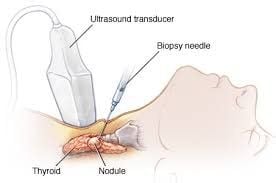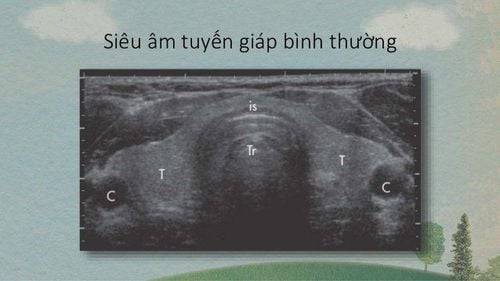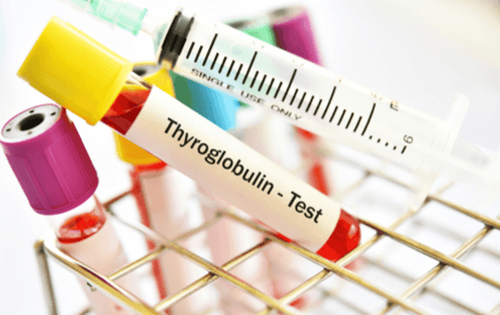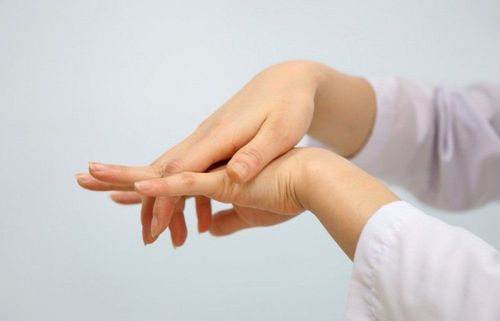This is an automatically translated article.
There are quite a few diseases related to the thyroid gland, and sometimes to distinguish them, find the exact problem, it is necessary to conduct a thyroid biopsy. Thyroid biopsy is also the gold standard for thyroid cancer diagnosis.
1. What is a thyroid biopsy?
A thyroid biopsy is a surgical procedure in which a sample of thyroid tissue is taken for examination under a microscope. Thyroid biopsies help differentiate several conditions, as well as being the gold standard for diagnosing cancer.
The appearance of abnormal masses in the thyroid gland is quite common, although they can cause different effects, but they are rarely malignant. The thyroid gland can also become enlarged due to enlargement, but this is not a malignancy.
Before being assigned a thyroid biopsy, the patient needs to have blood tests as well as imaging measures to know the functioning status of the thyroid gland. If there is any doubt, the doctor will recommend a thyroid biopsy.

Sinh thiết tuyến giáp giúp phân biệt một số bệnh lý và chẩn đoán ung thư
2. Meaning of Thyroid Biopsy
Thyroid enlargement or abnormal mass in the thyroid gland is usually not dangerous, but to get an accurate conclusion, sometimes a thyroid biopsy is needed. Thyroid abnormalities can be:
Thyroid cyst: Presents as an abnormal mass, in a fluid-filled mass, which can be painful and make it difficult for the patient to swallow, very rarely malignant but can be may require treatment. Basedow: Also known as Grave's disease, the thyroid gland is now enlarged and secretes excessive hormones. Hashimoto's thyroiditis: The thyroid gland is attacked by the body's immune system, damaged, and secretes less hormones than normal. Infection: Also makes the thyroid gland swollen and painful. Benign thyroid enlargement: Also known as a simple goiter, it can compress the structures around the thyroid gland, making it difficult for patients to breathe and swallow. Thyroid toxic nodules: One of the causes of thyroid hormone excess, but almost never of a malignant nature. Thyroid cancer: accounts for about 10% of all cases.
3. When should a thyroid biopsy be performed?
Thyroid biopsy helps doctors find the cause of an abnormal mass or enlargement of the thyroid gland, but not all thyroid problems require a biopsy, such as with Graves, to diagnose with a physical examination alone. , blood tests and diagnostic imaging.
With abnormal masses greater than 1cm in diameter, careful examination is required, especially if the imaging results show that it is a solid mass with calcification and the boundary of the mass is not clear.
Thyroid biopsy may also be indicated even if no abnormal mass is present if the patient is in severe pain and the thyroid gland is rapidly enlarging.
4. Thyroid Biopsy Techniques
Thyroid biopsy has many different techniques, including:
Fine needle aspiration (FNA) biopsy: The primary thyroid biopsy technique. This technique can be performed under ultrasound guidance. Your doctor will use a fine needle to collect a sample, which may be from a variety of locations (and possibly a lymph node near the thyroid). A fine needle aspiration thyroidectomy takes about 30 minutes, and does not require anesthesia, as the patient feels only a slight sting. After the technique is completed, the patient can rest for a while and then go home.

Chọc hút tuyến giáp bằng kim nhỏ là kỹ thuật sinh thiết tuyến giáp chủ yếu
Core needle biopsy: This is essentially the same as fine-needle aspiration thyroidectomy, but uses a larger needle. Needle core biopsy is performed when fine-needle aspiration results are not clear. Surgical Biopsy: This is a procedure that will require anesthesia, as well as a long recovery time.
5. What to prepare before thyroid biopsy?
Because fine-needle aspiration thyroidectomy is the primary thyroid biopsy technique, the preparation process is not complicated, mainly based on the existing medical condition and the medications the patient is taking. The doctor will give specific instructions for each patient, and the patient needs to actively consult with the doctor about their own questions, as well as write a commitment to agree to perform a thyroid biopsy.6. Possible risks of doing a thyroid biopsy
Thyroid biopsy is a relatively safe technique, with a very low complication rate, but there are still risks such as:
Bleeding Infection Damage to structures around the thyroid gland Because thyroid biopsies are mostly performed Under ultrasound guidance, damage to the structures surrounding the thyroid gland is rare.
7. What to do after a thyroid biopsy?
Since fine-needle aspiration thyroidectomy is the primary technique performed, the patient can go home with only a short rest. The puncture site may be sore for a day or two, and pain medication can be used to resolve. If there are special instructions from your doctor, follow them. If the biopsy results are not cancerous, most likely no further treatment will be needed (but it depends on the individual case). If necessary, the doctor will make an appointment for the patient to follow-up for follow-up, come to the doctor's appointment. If the biopsy results are cancerous, the patient may need surgery. Fortunately, most thyroid cancers are treatable. In some cases, the biopsy results are not clear (cannot be determined cancer or not), and the patient may need to have a biopsy again. It is best to choose large and reputable medical facilities not only in the hospital system in general but also stand out and take the lead in the field of cancer diagnosis and treatment.
For detailed advice on thyroid biopsy techniques at Vinmec, you can go directly to Vinmec medical system nationwide or contact to book an online examination HERE.
Articles refer to sources: hopkinsmedicine.org and webmd.com
MORE:
Common thyroid diseases Diagnosis and treatment of hyperthyroidism There are 10 signs, immediately think of thyroid disease













